#Second Brahmacharini
Text
नवदुर्गा- संपूर्ण कथा दूसरी ब्रह्मचारिणी | Navadurga
नवरात्री पर्व के दूसरे दिन माँ “ब्रह्मचारिणी” की पूजा-अर्चना की जाती है। साधक इस दिन अपने मन और ध्यान को माँ के चरणों में लगाते हैं। यदि विस्तार पूर्वक देखा जाये तो ब्रह्म का अर्थ है तपस्या और चारिणी यानी आचरण करने वाली। इस प्रकार ब्रह्मचारिणी का अर्थ होत
मुख पृष्ठ पोस्ट नवदुर्गा दूसरी ब्रह्मचारिणी
नवदुर्गा- दूसरी ब्रह्मचारिणी
।हिन्दी।।English।
नवरात्री पर्व के दूसरे दिन माँ “ब्रह्मचारिणी” की पूजा-अर्चना की जाती है। साधक इस दिन अपने मन और ध्यान को माँ के चरणों में लगाते हैं। यदि विस्तार पूर्वक देखा जाये तो ब्रह्म का अर्थ है तपस्या और चारिणी यानी आचरण करने वाली। इस प्रकार ब्रह्मचारिणी का अर्थ होता है तप का आचरण करने वाली।
माता देवी ने…
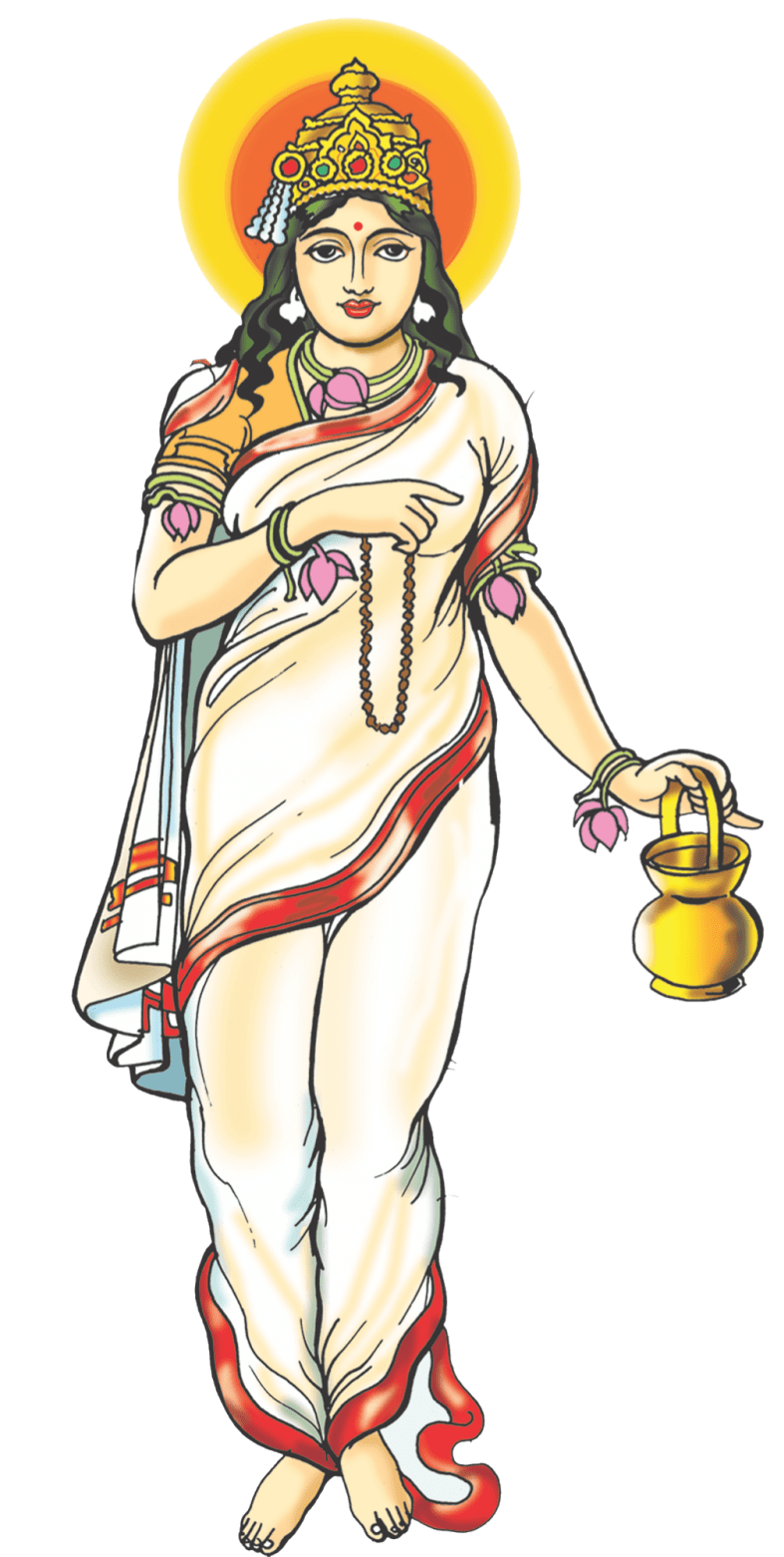
View On WordPress
#अखंड रामायण#द्वितीय ब्रह्मचारिणी#नवदुर्गा- द्वितीय ब्रह्मचारिणी#Hindu dharma#MNSGranth#Navadurga#Navratri#New post#Second Brahmacharini#Viral post#Viral Story
0 notes
Text

0 notes
Text
Goddess Brahmacharini

#Goddess Brahmacharini#is also an incarnation of Goddess Parvati. She is the symbol of calmness and peace. She holds a Japa Mala and a Kamandal on both of her han#Brahmacharini means a female who is devoted and who lives in Ashrama with her Guru. She is depicted as walking on bare feet.#She is also known as Devi Yogini and Devi Tapsvini. Goddess Brahmacharini personifies love and loyalty and she is also known as the epitome#The second day of Navratri is dedicated to Goddess Brahmacharini who is also considered as the ruler of planet Mars as devotees who worship#cab service
1 note
·
View note
Text
Day two of Navratri
9 days , 9 Godesses

Day Two: Brahmacharini | ब्रह्मचारिणी
Epitome of Tapas
Brahmacharini represents Parvati in her phase of tapas. She walks barefoot carrying the japa mala in her right hand and kamandalu in her left.
On the second day, we should stop all the fripperies of life and take to deep penance and spend this night in meditation alone.
“Aum Devi Brahmacharinnyai Namaha!”
ॐ देवी ब्रह्मचारिण्यै नमः॥
Jai Maa Durga ����
25 notes
·
View notes
Text
🌺Jai Maa Brahmacharini🌺
Day-2
“Goddess Brahmacharini, the second form of Maa Durga, symbolizing the path of devotion and penance, inspiring us to follow the righteous way. 🌺🙏 #GoddessBrahmacharini #Navaratri #Devotion #Penance #navratri #day2 #devartai
22 notes
·
View notes
Text
Pearl White Viscose Rayon Thread Embroidered Navratri Lehenga Choli

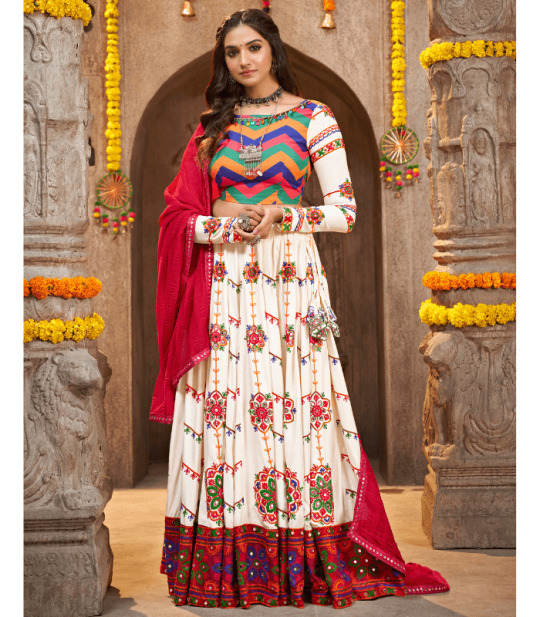

The colour for the second day of Navratri, dedicated to Goddess Brahmacharini is White. you can get Pearl White Navratri Lehenga Choli on zakarto.com
Shop: https://tinyurl.com/ytqlwwc3
#gujarat#usa#canada#international#zakartoindia#uae#uk#india#navratri#navratrilehenga#navratricollection#navratrichaniyacholi#k#navratrispecial#navratrioutfit#lehenga#lehengacholi#navratrijewellery#navratrifestival#navratrivibes#navratrilook#bridallehenga#navratrifever#weddinglehenga#navratriwear#navratrigarba#indianfashion#navratrinights#navratriutsav#whitenaratrilehenga
5 notes
·
View notes
Text
Navadurga and significance of each day of Navratri
Devi is worshipped in 9 forms known as Navadurga. The significance of each day of Navratri is attached to a form of the Mother Divine.
First Day – Shailaputri

On the first day, Devi Shailaputri is worshipped. In this form, Devi Parvati is revered as the daughter of Himalaya Raja. Shaila means extraordinary or rising to great heights. The divine consciousness represented by Devi always surges from the peak. On this first day of Navratri, we propitiate Devi Shailaputri so that we may also attain the highest state of consciousness.
Second Day – Brahmacharini
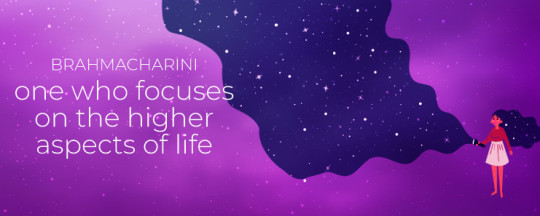
On the second day, Devi Brahmacharini is propitiated. Devi Brahmacharini is the form of Devi Parvati in which she undertook severe penance to have Lord Shiva as Her consort. Brahma means divine consciousness and achar refers to behavior. Brahmacharya is the behavior or an act that is established in divine consciousness. This day is especially sacred to meditate and explore our inner divinity.
Third Day – Chandraghanta
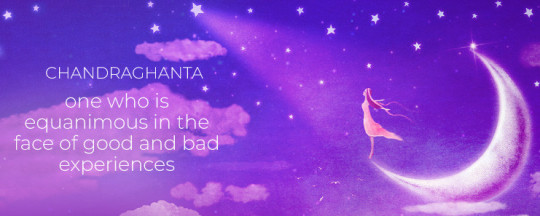
On the third day, Devi Chandraghata is the presiding Devi. Chandraghata is the special form that Devi Parvati assumed at the time of Her marriage with Lord Shiva. Chandra refers to the moon. The moon represents our mind. The mind is restless and keeps moving from one thought to another. Ghanta is a bell which produces only one kind of sound always. The significance is that when our mind is established at one point, i.e Divine, then our prana (subtle life force energy) gets consolidated leading to harmony and peace. This day thus signifies withdrawing from all vagaries of the mind, with a single focus on Mother Divine.
Fourth Day – Kushmanda

On the fourth day, Mother Divine is worshipped as Devi Kushmanda. Kushmanda means a pumpkin. Ku means little, ushma means energy and anda refers to egg. This entire universe which arose from the cosmic egg (hiranyagarbha) is manifested from an infinitesimal energy of Devi. A pumpkin also represents prana as it has the unique property of absorbing and radiating prana. It is one of the most pranic vegetables. On this day, we worship Devi Kushmanda who showers us with Her divine energy.
Fifth Day - Skandamata

Skandamata means Mother of Skanda. On the fifth day, the motherly aspect of Devi Parvati is worshipped. In this form, she is the mother of Lord Karthikeya. She represents motherly affection (vatsalya). Worshiping this form of Devi brings abundance of wisdom, wealth, power, prosperity and liberation.
Sixth Day – Katyayani

On the sixth day, Devi manifests as Katyayani. It is a form that Mother Divine assumed to annihilate the demonic forces in the universe. She was born from the anger of the gods. She is the one who slayed Mahishasura. As per our scriptures, anger that supports dharma (righteousness) is acceptable. Devi Katyayani represents that divine principle and form of the Mother Divine who is behind natural calamities and disasters. She is the anger that arises in creation to restore balance. Devi Katyayani is invoked on the sixth day to put an end to all our inner foes that are an obstacle on the path of spiritual evolution.
Seventh Day – Kalaratri
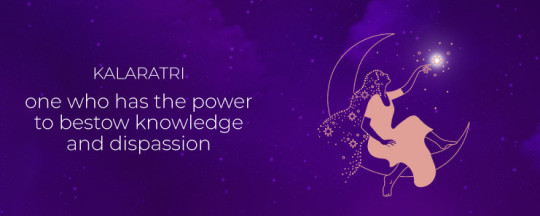
On the seventh day, we invoke Devi Kalaratri. Mother Nature has two extremes. One is terrifying and devastating. The other is beautiful and serene. Devi Kalaratri is a fierce form of Devi. Kalaratri represents the dark night. Night is also considered an aspect of Mother Divine as it is night that brings solace, rest and comfort to our souls. It is only at night that we get a glimpse of infinity in the skies. Devi Kalaratri is that infinite dark energy that houses innumerable universes.
Eighth Day – Mahagauri

Devi Mahagauri is that which is beautiful, gives momentum and freedom in life. Mahagauri represents the beautiful and serene aspect of Nature. She is that energy which propels our lives and also liberates us. She is the Devi who is worshipped on the eighth day.
Ninth Day - Siddhidatri
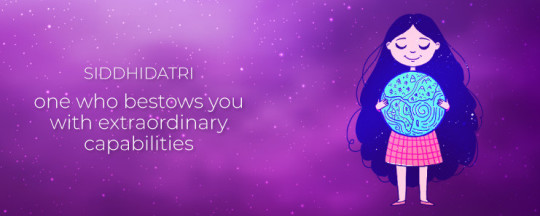
On the ninth day, we worship Devi Siddhidatri. Siddhi means perfection. Devi Siddhidatri brings perfection in life. She makes the impossible, possible. She takes us beyond the ever reasoning logical mind to explore the realm beyond time and space.
Jai Mata Ji!
4 notes
·
View notes
Text
Worship Maa Brahmacharini - Gayatri Mata on the second day of Navaratri
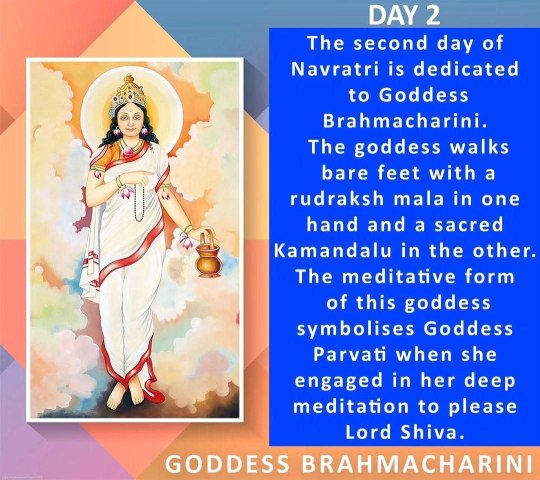
🌹 Worship Maa Brahmacharini - Gayatri Mata on the second day of Navaratri 🌹
On the second day of Navaratri, Maa Brahmacharini - a manifestation of Maa Durga - is worshipped. The form of Goddess Brahmacharini is extremely radiant and majestic. Maa signifies love and loyalty, wisdom and knowledge. She holds a rosary in her hight hand and a Kamandal in her left hand. She wears Rudraksha. The word "Brahm" refers to Tapa (penance) - Her name means "one who performs Tapa (penance)".
She was born to Himalaya. Devrishi Narada influenced her thoughts and as a result, she practised tough penances as she was determined to obtain Lord Shiva as her divine consort. She spent hundred of years eating very little or nothing at all, but her penance was so pure and had so much strength, power that it caused great disturbance in all the three worlds. Her desire to obtain Lord Shiva as her divine consort was eventually fulfilled.
Goddess Brahmcharini blesses you with great emotional strength and you may be able to keep your mental balance and confidence even in the darkest hour. She inspires you to hold on to your ethics and march on the path of duty. By the grace of Maa Brahmacharini, you strive to move forward in life without getting disheartened by the numerous challenges coming your way. Her blessings help you get rid of selfishness, ego, greed and laziness.
The Mantra And Other Facts About Maa Brahmacharini:
Maa Brahmacharini Dhyan: Dadhaana Kar Padmabhyam Akshmala Kamandalu, Devi Prasidatu Mayi Brahmacharinyanuttama.
Maa Brahmacharini Mantra for the second day of Navratri:
Om Brahm Brahmacharinyai Namah. (Chant it 108 times).
Colour of the second day: Orange.
Prasad of the second day: Sugar and unsalted butter. - coconut rice, Sweet Rice
Governing Planet: It is believed that Lord Mangal, the provider of all fortunes, is governed by Goddess Brahmacharini.
🌹 🌹 🌹 🌹 🌹
#జ్ఞానవాహిని#Spiritual#Bhakthi#Insight#సందేశాలు#Jnanavahini#message of the day#Devi Navaratri#prasad bharadwaj
2 notes
·
View notes
Text
Navratri 2023 Colors: A Guide to the Significance of 9 Days of Sharad Navratri Attire
Navratri, the nine-night festival dedicated to the worship of Goddess Durga, is celebrated with great enthusiasm and devotion in India, especially in states like Maharashtra and Gujarat. One of the captivating traditions during Navratri is the daily choice of colors to wear, each associated with a different form of the goddess. This practice holds deep significance in Hindu culture, symbolizing purity. Let's take a closer look at the Navratri colors to be followed this year and the gods and goddesses they represent.
Day 1: Pratipada - Shailputri
On the first day of Navratri, Goddess Shailputri is venerated, also known as Parvati, the daughter of the Himalaya mountains. The color for this day is Orange, symbolizing energy and enthusiasm.

Image Courtesy: Pinterest
Adorn yourself in an elegant Orange and red Ikkat Pure Pochampally Handloom Saree to honor the goddess's strength and grace.

Day 2: Dwitiya - Brahmacharini
Mata Brahmacharini, the goddess celebrated on the second day, signifies eternal peace. White, the color of serenity, is the choice for Day 2.
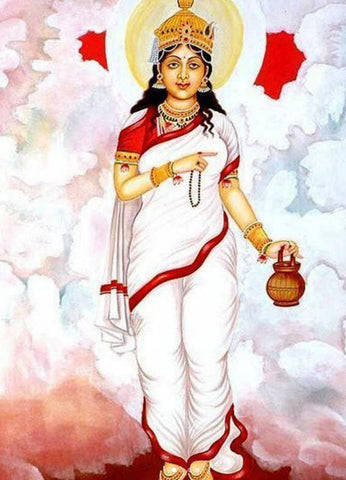
Image Courtesy: Online live daily news
A Pearl White Color Mirror Work Viscose Rayon Navaratri Lehenga Choli reflects the goddess's tranquil and pure nature.
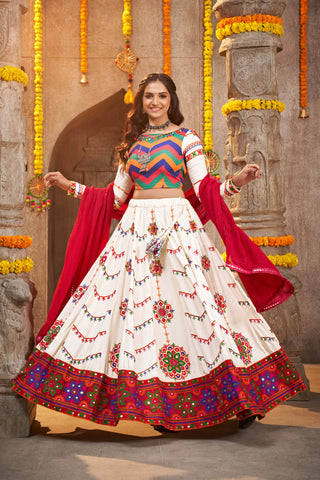
Day 3: Tritiya - Chandraghanta
On Tritiya, we worship Mata Chandraghanta, who rides a lion and is believed to vanquish evil forces. Red, the color of health, courage, and love, is the color of choice.

Image Courtesy: Pinterest
Embrace this vibrant hue with a Red saree cutdana work to channel your inner strength.
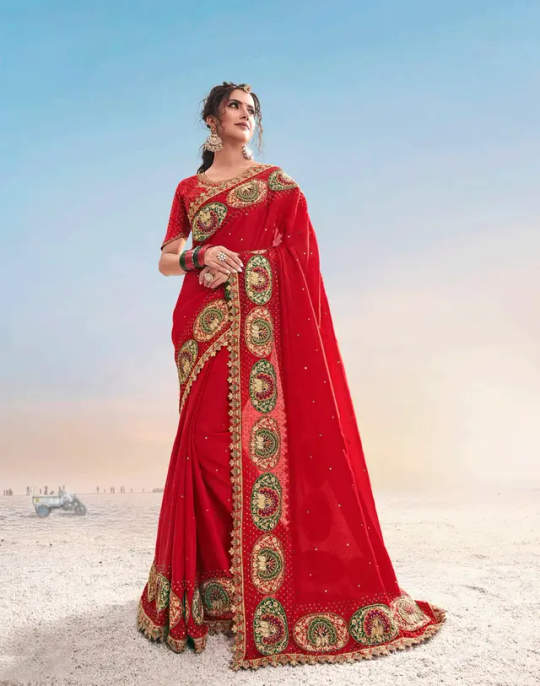
Day 4: Chaturthi - Kushmanda
The fourth day celebrates Mata Kushmanda, who is said to have created the cosmic egg with her smile, bringing light to the universe. Royal Blue, representing elegance and royalty, is the color for this day.

Image Courtesy: Pinterest
Grace the occasion with a splendid Navratri Chaniya Choli in this mesmerizing shade of Blue.
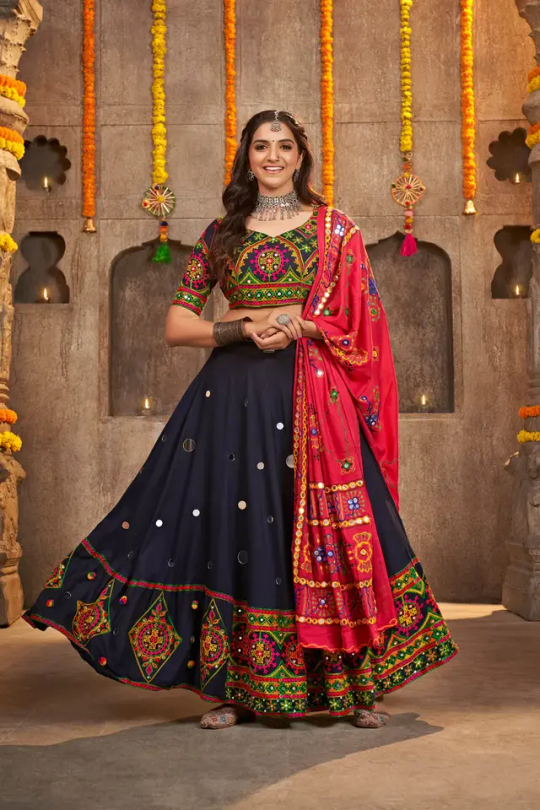
Image Courtesy: Pinterest
Day 5: Panchami - SkandMata
Mata Skandmata, honored on the fifth day, is associated with good health. This day is dedicated to Green, symbolizing nature and prosperity.

Image Courtesy: Pinterest
Wear this beautiful green saree to align with the goddess's blessings.

Day 6: Shashthi - Katyayani
Mata Katyayani, the sixth form of Mata Durga, is the granter of health and happiness. Grey, a vibrant and versatile color, is chosen for this day's celebrations.

Image Courtesy: Pinterest
Grace the occasion with a Grey Anarkali Dress
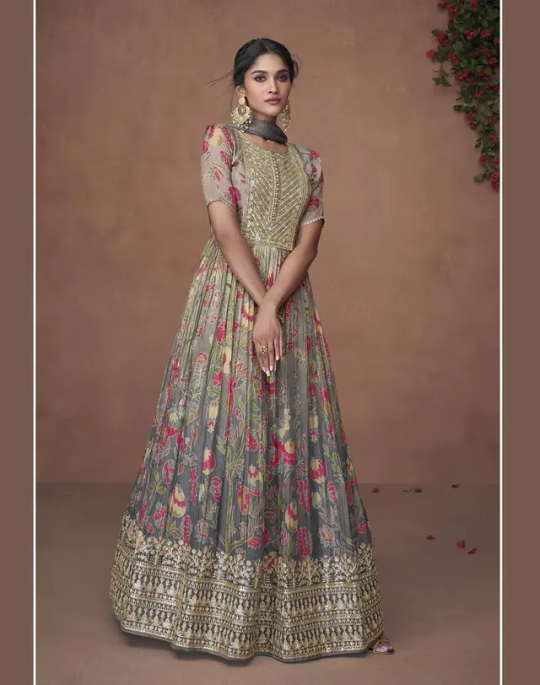
Day 7: Saptami - Kaalratri
Maa Kaalratri, worshipped on the seventh day, protects against evil forces. Orange is the color for Saptami, reflecting the fervor of Navratri celebrations.

Day 8: Ashtami - Mahagauri
Maa Mahagauri, associated with peace and intelligence, is revered on the eighth day.

Image Courtesy: Pinterest
Adorn yourself in Peacock Green indian saree, a sublime shade that complements the goddess's virtues.

Day 9: Navami - Siddhidatri
On the ninth and final day, we honor Maa Siddhidatri, the granter of divine blessings. Pink, a combination of the energy of red and the stability of blue, is chosen. This color symbolizes opulence and richness as we seek the goddess's supreme blessings.

Image Courtesy: Pinterest
During Navratri, people wear different colors each day to show that they are all together and devoted. It's like a colorful journey through different forms of the Goddess Durga, who is very special. When you celebrate Navratri, make sure to wear colors that show how much you love and respect the divine.
Explore the exquisite collection of Navratri attire at Mohi Fashion, featuring enchanting Chaniya Choli, Navratri Ghagra Choli, Anarkali suit, sarees, and stylish sharara suit, all available online. We proudly offer worldwide shipping, catering to fashion enthusiasts in the USA, Australia, UK, Canada, India, and beyond. Join us in celebrating the spirit of Navratri with elegance and style.
#navratri#lehenga#indian ethnic wear#sareelove#sareeonline#bride#wedding#indianfashion#sareecollection#bollywood#bollywood actress#ootd
2 notes
·
View notes
Text
नवदुर्गा- संपूर्ण कथा दूसरी ब्रह्मचारिणी | Navadurga
नवरात्री पर्व के दूसरे दिन माँ “ब्रह्मचारिणी” की पूजा-अर्चना की जाती है। साधक इस दिन अपने मन और ध्यान को माँ के चरणों में लगाते हैं। यदि विस्तार पूर्वक देखा जाये तो ब्रह्म का अर्थ है तपस्या और चारिणी यानी आचरण करने वाली। इस प्रकार ब्रह्मचारिणी का अर्थ होत
मुख पृष्ठ पोस्ट नवदुर्गा दूसरी ब्रह्मचारिणी
नवदुर्गा- दूसरी ब्रह्मचारिणी
।हिन्दी।।English।
नवरात्री पर्व के दूसरे दिन माँ “ब्रह्मचारिणी” की पूजा-अर्चना की जाती है। साधक इस दिन अपने मन और ध्यान को माँ के चरणों में लगाते हैं। यदि विस्तार पूर्वक देखा जाये तो ब्रह्म का अर्थ है तपस्या और चारिणी यानी आचरण करने वाली। इस प्रकार ब्रह्मचारिणी का अर्थ होता है तप का आचरण करने वाली।
माता देवी ने…

View On WordPress
#अखंड रामायण#द्वितीय ब्रह्मचारिणी#नवदुर्गा- द्वितीय ब्रह्मचारिणी#Hindu dharma#MNSGranth#Navadurga#Navratri#New post#Second Brahmacharini#Viral post#Viral Story
0 notes
Text

Brahmacharini : The Celibate Goddess
Worshipped on the second day of the Navratris, Goddess Parvati took this form when she underwent severe tapasya in the Himalayas to please Lord Shiva and marry him. This form is also called Aparna, or She Who Forsook Leaves, since the goddess stopped eating food, drinking water and in the later stages, even breathing.
8 notes
·
View notes
Text
Top 9 Navratri Outfits for Women in 2024
Navratri is one of the most vibrant and deeply motivating celebrations in India. Holidays such as the serene Durga puja in Bengal and the Garba evenings in Gujarat blend spirituality, devotion, and, of course, colorful ethnic wear. Navratri is the perfect time to flaunt your Navratri clothes for ladies and keep a spiritual connection because it honors a different goddess every day and each goddess has a different hue. Let's examine a few fashionable yet classic looks for each day of Navratri in 2024!
Day 1: Yellow – Goddess Shailaputri
The festival of Navratri begins with a tribute to Goddess Shailaputri, a symbol of strength and calm. Happiness and inspiration belong to yellow. Start the festivities with a bright yellow Anarkali or kurta combo. Use golden jhumkas, bangles, and loose, delicate curls to add some elegance to the outfit. If you wear flowing Cotton Culture clothing, you can look fashionable and feel at ease.
Day 2: Green – Goddess Brahmacharini
On the second day, we worship the goddess Brahmacharini, who stands for learning and calm. Green symbolizes peace and growth. A green palazzo set from Cotton Culture is perfect for this specific day. Wear it with jewelry that has been oxidized to silver for a refined look. Keep your hair simple with a half-up, half-down style to strike a balance between ease and style.
Day 3: Grey – Goddess Chandraghanta
Grey belongs to the goddess Chandraghanta and is a color of strength and impartiality. Anarkali or kurta in shades of gray, modest yet elegant, combines strength and grace. Wear this with a sleek ponytail and large silver accessories to keep your look professional. Grey is a very classy and understated hue that's perfect for a day of dedication or celebration.
Accessories & Hairstyles
For women, accessories are crucial to finishing off your ethnic attire. While silver-oxidized jewelry looks excellent with women's Navratri costumes like kurtas and palazzo combinations, gold jewelry pairs nicely with sarees and lehengas. Bracelets, bindis, and anklets can provide the perfect celebratory touch to the ensemble. In addition to being gorgeous, hairstyles like high buns, braids, and gentle waves also stay tidy during the busy Garba nights!
Conclusion
Navratri is the perfect time to celebrate your passion of ethnic wear and reflect on the spiritual significance of each day. Embrace the hues of the day to honor the goddess in style, whether you choose to wear an exquisite kurta combination or a dazzling lehenga choli. Make sure your wardrobe is both festive and comfortable by checking out Cotton Culture's selection of women's ethnic clothing and Navratri ensembles.
Hey, Read more about navratri outfits
1 note
·
View note
Text

Navratri Festival 2024
visit here Blog - Best Indian art and culture | Indradigi.com
India is a very big country, people of all religions reside in it, people of all religions have their own festivals. Like Deepawali, Dussehra, Eid, Raksha Bandhan, Lohri, Teej, Holi, Navratri etc. Navratri Festival is considered a major festival in Hinduism. This festival is known as the worship of nine forms of Goddess Durga. Although this festival is celebrated with great pomp throughout India, but it has great importance in some states like Gujarat, West Bengal, Maharashtra and Uttar India etc. This festival is celebrated in the form of Maa Durga Upasana in 9 days and nights, it literally means “nine nights” Although the festival of Navratri comes four times in every year, but among these, Shardiya Navratri and Chaitra Navratri are considered to be of great importance. Shardiya Navratri comes either in September or October.
What is the religious significance of Navratri Festival
The festival of Navratri has great significance from the religious point of view because on this day Goddess Durga won religion over unrighteousness by killing a demon named Mahishasura. Navratri is also seen as the victory of religion over Adharam. This festival is believed to be related to Goddess Durga, who is the goddess of power, this festival lasts for 9 days and on these nine days, Goddess Durga is worshipped in different forms.
Nine forms of Navadurga:
Shailputri: Daughter of Parvat Raj Himalaya, she is worshipped on the first day of Navratri.
Brahmacharini: The epitome of sadhana and restraint, is the goddess of the second day.
Chandraghanta: A symbol of strength and courage, she is worshipped on the third day.
Kushmanda: The goddess who created the universe, she is worshipped on the fourth day.
Skandamata: Mother of Lord Kartikeya, she is worshipped on the fifth day.
Katyayani: Mahishasura Mardini is worshipped on the sixth day.
Kalratri: The goddess who destroys all kinds of fear and negativity, she is worshipped on the seventh day.
Mahagauri: Goddess of peace and compassion, she is worshipped on the eighth day.
Siddhidatri: The giver of siddhis and powers, she is worshipped on the ninth day.
Legend related to Navratri Festival
Although there are many stories related to Navratri, but the most prominent story is believed to be the war between Goddess Durga and Mahishasura, Mahishasura was a very powerful demon who got a boon from Lord Brahma that no man could kill him.
https://indradigi.com/wp-content/uploads/2024/09/R-4-1536x1152.jpeg
Due to this boon, the demon had become very powerful and had also become very tyrannical, due to which he had also defeated many gods, then the gods worshipped Goddess Durga and Goddess Durga fought with Mahishasura for 9 days. On the other hand, Lord Rama fasted on Navratri to worship Shakti before the battle with Ravana. or Ravana was killed on the tenth day. This festival is also seen as the victory of Rama and the defeat of Ravana.
Cultural Significance of fast
Navratri festival is celebrated in different forms in different parts of India like in Gujarat, people play dandiya, do garba and go to new places. In Maharashtra too, Garba and Dandiya are celebrated a lot. While in West Bengal this festival is celebrated in a different way, in the last five days Goddess Durga is worshipped, her very huge idols are installed and.
On the tenth day, it is immersed. This festival is also very important in North India, people in Uttar India keep fast, on this day people worship the Mother Goddess, this puja lasts for eight days, on the ninth day, nine girls are honored by sitting as a goddess.
What are Navratri rules and fast
Fasting during the Navratri festival is considered very virtuous, people who fast use satvik food and stay away from non-vegetarian things. The purpose of this festival is not only physical penance, spiritual but also mental and spiritual purification.
The rules of this fast are as follows
Eating fruits at a time or drinking only water
According to this fast, one should eat satvik food once a day
Those who observe this fast should exercise physical and mental restraint
As I just told you, Goddess Durga is worshipped in this fast, so this fast also rules that during this time the Goddess should be worshipped
Last Day of Dussehra Navratri
The festival of Dussehra comes on the tenth day of Navratri Festival, or rather, the festival of Dussehra is celebrated on the tenth day, on this day Sri Rama God declared the victory of good over evil by killing Ravana. And Maa Durga also killed Mahishasura and won good over evil, on this day effigies of Ravana, Meghnad, Kumbhakarna are burnt.
Navratri Festivals and Modern Society
The festival of Navratri is considered very important not only from religious point of view but also from social point of view, this Navratri Festival is celebrated in general, Goddess Durga is worshipped collectively, which promotes the feeling of unity. Fairs are organized on the day of good Navratri; a large number of people participate in it.
Conclusion
From this festival, we get the education that no matter how complex the evil is, 1 day it definitely ends, as we have just seen, Durga Maa had won by killing Mahishasura, victory of good over evil. On the other hand, we get another example where Lord Ram killed Ravana and won good over evil.
Navratri festival is an integral part of Indian culture, it is important not only from religious and spiritual point of view but also from social and cultural point of view. On the day of Navratri, people worship Goddess Durga to awaken their inner and outer powers.
0 notes
Text
The Power of Navratri Colors: Adorning Yourself with Meaning
Navratri is more than dance and devotion; it’s a celebration of vibrant colors with profound meaning. Each day corresponds to a specific color symbolizing a worshiped goddess. Color-themed jewelry isn’t just adornment; it’s a spiritual alignment, fostering power, determination, and courage. These pieces enhance your aura, connecting you to divine energy and the goddess’s attributes.
Let’s explore the powerful meanings behind the Navratri colors and how adorning yourself in these hues can invoke blessings and transformation in your life. Here are some jewelry ideas for you to accessorize for the Navratri Looks!
Orange Day 1 – Power and Discipline
On the first day of Navratri, we celebrate Goddess Shailputri, symbolizing nature’s unshakable strength and the fulfillment of wishes. Wearing vibrant orange aligns us with her power and discipline. Embrace Shailputri’s blessings and embark on your Navratri journey, rooted in strength. To enhance your connection with Shailputri’s blessings, consider adorning yourself with stunning orange-themed jewelry from Jagdamba Pearls. These accessories complement your outfit, empower you with the goddess’s strength, and add an extra touch of spirituality to your Navratri celebration. Explore our collection to choose the perfect pieces for this auspicious day.
White Day 2 – Innocence and Purity
On the second day, we honor Goddess Brahmacharini, the ‘Ascetic Goddess,’ with the purity of white. It signifies righteousness, innocence, and inner peace, offering harmony in trying times. Wearing white aligns us with her dedication and strength. Embrace this color, connecting with a peaceful energy that guides us toward integrity and purpose. Enhance your look with exquisite pearls from Jpearls, including pendant sets, bangles, and choker necklaces, to make your look complete and Pearl-Fect! Here are a few Pearl accessory options to pair your outfit with!
Red Day 3 – Vibrancy, Passion
Red, the color of creativity and passion, perfectly suits this day of Chandraghanta, ‘the Peacemaker.’ Her name symbolizes a divine sound and creative power. Wearing red ignites vitality and the spark of creativity, celebrating self-expression and positive change. Chandraghanta’s laughter, like the sea’s roar, is believed to have birthed the Universe’s fostering innovation and harmony. For Navratri’s third day, consider wearing red jewelry, such as red gemstones or accessories with red elements. Let the color red infuse your day with inspiration, enthusiasm, and a surge of creative energy, mirroring the qualities of Goddess Chandraghanta.
Blue Day 4 – Light, Positivity and Boundless Creativity
On the fourth day, celebrate Goddess Kushmanda, ‘the creator of the Universe’, who filled it with light and positivity. The color blue, representing the vast universe and its boundless creativity, is perfect for this day. Wear shades of blue and complement your attire with blue jewelry, like Sapphire and Aquamarine gemstones, known for serenity and spiritual growth. Explore our Royal Blue Sapphire jewelry collection at Jpearls to add a touch of perfection to your outfit with plenty of options. Embrace this divine energy with the serene charm of blue accessories.
Yellow Day 5 – Fearlessness and Determination
On the sixth day of Navratri, we celebrate Goddess Skandamata with the color yellow, signifying fearlessness and determination. Embrace this day’s energy with yellow topaz gemstones, gold jewelry, or yellow-themed accessories, fostering strength and confidence. Adorning yourself in yellow jewelry connects you with the protective qualities of Skandamata, invoking her blessings for courage and empowerment. Enhance your look, mirror the goddess’s love and protection, and step into the world with newfound strength and confidence.
Green Day 6 – Serenity and Harmony
Goddess Katyayani is revered for her peaceful and calming presence. Her favorite color, green, mirrors her ability to bring balance and serenity to our lives. Wearing green on this day signifies our connection with Katyayani’s peaceful energy and her capacity to restore harmony in times of chaos. To embrace the energies of this day, we recommend you accessories your emerald look with these jewelry choices, that reflect the themes of growth, renewal, and purification. Our top picks for you will be, Green emerald gemstone, Peridot or Jade Jewelry, necklaces or rings that resonate perfectly with the day’s color.
Grey Day 7 – Power and Transformation
On the seventh day of Navratri, devotees honor Kalaratri, the Dark Goddess, a fierce and powerful form of Goddess Durga. The color associated with this day is grey, signifying the deep strength and determination required to face and conquer life’s challenges. Kalaratri is a symbol of transformation, renewal, and the relentless pursuit of truth with the divine energy of the day. These jewelry choices like Grey Pearl, Smoky Quartz, and Labradorite Jewelry, not only complement your outfit but also help you connect more deeply and inspire you to face life’s challenges with a grounded sense of determination and inner strength, just as Kalaratri embodies the spirit of relentless pursuit and transformation. Check out Jagdambas Pearl’s best offer this festive season on jewelry designs you’ll love.
Purple Day 8 – Tranquility and Enlightenment
On the eighth and final day of Navratri, devotees honor Mahagauri, ‘the Pure Goddess’. She embodies purity, tranquillity, and the enlightenment that comes from cleansing one’s body, mind, and soul. The color associated with this day is purple, symbolizing spirituality, transformation, and the culmination of one’s spiritual journey. Amethyst, Lepidolite, and Purple Sapphire Jewelry are excellent choices to adorn on this day. These jewelry pieces signify your alignment with spirituality, mysticism, and the blessings associated with Mahagauri, allowing you to complete your spiritual journey with grace and enlightenment.
Peacock Green Day 9 – Kindness, Love, and blooming of new possibilities
On the final day of Navratri, we celebrate Goddess Siddhidatri, ‘the Bestower of Boons’, who grants her devotees their deepest desires and fulfills their wishes. She represents ultimate knowledge and the divine feminine force. The color associated with this day is peacock green, symbolizing growth, renewal, and the grace of the Goddess. The color associated with this day is Peacock Green. Siddhidatri is revered as the source of all mystic and spiritual powers. Our recommended jewelry choices for the day are from Peacock feather and Floral-themed inspired designs to adorn Green Jade gemstones and Malachite Jewelry.
Conclusion:
In conclusion, Navratri is more than just a celebration of dance and devotion; it’s a vibrant festival of colors, each carrying profound meaning and symbolism. As we celebrated the nine nights of Navratri, we discovered the deep significance of each color and how wearing these shades can inspire you with the qualities of the goddesses being honored. These colors correspond to the worship of various goddesses and are not merely adornments but symbols of spiritual alignment. Wearing color-themed jewelry during Navratri enhances your aura, connecting you to the divine energy of the goddess of the day and invoking blessings and transformation in your life. We wish you all a Happy Navratri!
0 notes
Link
0 notes
Text
Goddess Brahmacharini: Embracing Austerity and Spiritual Discipline
Goddess Brahmacharini is particularly associated with the concept of penance and self-discipline. Her worship is believed to bring clarity, patience, and perseverance to devotees who seek to follow a path of spiritual growth.
0 notes